Uncertainty of the X-ray Diffraction (XRD) sin2 ψ Technique in Measuring Residual Stresses of Physical Vapor Deposition (PVD) Hard Coatings
Abstract
:1. Introduction
2. Experimental Procedure and Stress Calculation
2.1. The Sample Material
2.2. XRD Experiments
2.3. Calculation of Residual Stresses
3. Results and Discussion
3.1. Residual Stresses Measured under the {hkl} Mode
3.2. Residual Stresses Measured under the GIXRD Mode
3.3. Effect of X-ray Attenuation on the Results of Residual Stress Calculation
3.4. Effect of Anisotropic Elastic Modulus on the Calculated Residual Stress Values
4. Conclusions
- The incident Ω angle has decisive influence on the effective X-ray penetration that the penetration increases significantly with the increase of the Ω angle. On the other hand, for a given Ω angle, the effect of the employed diffraction angle 2θ, i.e., the {hkl} crystalline plane, is negligible.
- When measuring using the conventional d-sin2 ψ mode, it is necessary to select a lattice plane of high diffraction angle. The results present the approximate estimation of overall residual stress over the depth of effective X-ray penetration. In the case of TiN coating, as shown in the current study, the residual stresses measured from the diffraction peaks of high-index planes from {311} to {422} are comparable to each other. On the other hand, measurements from the low-index planes {111}, {200} and {220} give rise to extraordinarily high values.
- When measuring using the GIXRD mode, the calculated residual stress depends strongly on the X-ray penetration depth as predominantly determined by the incident Ω angle. This method helps determine a depth profile of residual stress in a coating of heterogeneous growth structure.
- The anisotropy of elastic modulus has a certain influence on the calculation of residual stress, while the influence is not pronounced as compared to the incident Ω angle.
Author Contributions
Conflicts of Interest
References
- Cullity, B.D.; Stock, S.R. Elements of X-ray Diffraction, 3rd ed.; Prentice Hall: Upper Saddle River, NJ, USA, 2001; p. 435. [Google Scholar]
- Noyan, I.C.; Cohen, J.B. Residual Stress—Measurement by Diffraction and Interpretation; Springer: New York, NY, USA, 1987; pp. 117–163. [Google Scholar]
- Malhotra, S.G.; Rek, Z.U.; Yalisove, S.M.; Bilello, J.C. Analysis of thin film stress measurement techniques. Thin Solid Films 1997, 301, 45–54. [Google Scholar] [CrossRef]
- Fitzpatrick, M.E.; Fry, A.T.; Holdway, P.; Kandil, F.A.; Shackleton, J.; Suominen, L. Measurement Good Practice Guide No. 52. Determination of Residual Stresses by X-ray Diffraction—Issue 2; National Physical Laboratory: London, UK, 2006. [Google Scholar]
- Portinha, A.; Teixeira, V.; Carneiro, J.; Beghi, M.G.; Bottani, C.E.; Franco, N.; Vassen, R.; Stoever, D.; Sequeira, A.D.L. Residual stresses and elastic modulus of thermal barrier coatings graded in porosity. Surf. Coat. Technol. 2004, 188–189, 120–128. [Google Scholar] [CrossRef]
- Scardi, P.; Polonioli, P.; Ferrari, S. Residual stress in stabilized zirconia thin films prepared by RF magnetron sputtering. Thin Solid Films 1994, 253, 349–355. [Google Scholar] [CrossRef]
- Kim, J.O.; Achenbach, J.D.; Mirkarimi, P.B.; Shinn, M.; Barnett, S.A. Elastic constants of single-crystal transition-metal nitride films measured by line-focus acoustic microscopy. J. Appl. Phys. 1992, 72, 1805–1811. [Google Scholar] [CrossRef]
- Perry, A.J.; Jagner, M.; Sproul, W.D.; Rudnik, P.J. The residual stress in TiN films deposited onto cemented carbide by high-rate reactive sputtering. Surf. Coat. Technol. 1989, 39–40, 387–395. [Google Scholar] [CrossRef]
- Quaeyhaegens, C.; Knuyt, G.; Stals, L.M. Study of the residual macroscopic stress in TiN coatings deposited on various steel types (TuSA1). Surf. Coat. Technol. 1995, 74–75, 104–109. [Google Scholar] [CrossRef]
- Liu, H.; Xu, Q.; Zhang, X.; Wang, C.; Tang, B. Residual stress analysis on TiN film fabricated by plasma immersion ion implantation and deposition process. Nucl. Instrum. Methods Phys. Res. 2013, 297, 1–6. [Google Scholar] [CrossRef]
- Hohl, F.; Stock, H.-R.; Mayr, P. Examination of residual stress, morphology and mechanical properties of sputtered TiN films. Surf. Coat. Technol. 1992, 54–55, 160–166. [Google Scholar] [CrossRef]
- Saerens, A.; Houtte, P.V.; Meert, B.; Quaeyhaegens, C. Assessment of different X-ray stress measuring techniques for thin titanium nitride coatings. J. Appl. Crystallogr. 2000, 33, 312–322. [Google Scholar] [CrossRef]
- Welzel, U.; Ligot, J.; Lamparter, P.; Vermeulen, A.C.; Mittemeijer, E.J. Stress analysis of polycrystalline thin films and surface regions by X-ray diffraction. J. Appl. Crystallogr. 2005, 38, 1–29. [Google Scholar] [CrossRef]
- Benegra, M.; Lamas, D.G.; de Rapp, M.E.F.; Mingolo, N.; Kunrath, A.O.; Souza, R.M. Residual stresses in titanium nitride thin films deposited by direct current and pulsed direct current unbalanced magnetron sputtering. Thin Solid Films 2006, 494, 146–150. [Google Scholar] [CrossRef]
- Skrzypek, S.J.; Baczmanski, A.; Ratuzek, W.; Kusior, E. New approach to stress analysis based on grazing-incident X-ray diffraction. J. Appl. Crystallogr. 2001, 34, 427–435. [Google Scholar] [CrossRef]
- Lewis, D.B.; Wadsworth, I.; Münz, W.D.; Kuzel, R., Jr.; Valvoda, V. Structure and stress of TiAlN/CrN superlattice coatings as a function of CrN layer thickness. Surf. Coat. Technol. 1999, 116–119, 284–291. [Google Scholar] [CrossRef]
- Genzel, C. X-ray stress analysis in presence of gradients and texture. Adv. X-ray Anal. 2001, 44, 247–257. [Google Scholar]
- Marques, M.J.; Dias, A.M.; Gergaud, P.; Lebrun, J.L. A methodology development for the study of near surface stress gradients. Mater. Sci. Eng. 2000, 287, 78–86. [Google Scholar] [CrossRef]
- Jegou, S.; Christiansen, T.L.; Klaus, M.; Genzel, C.; Somers, M.A.J. Determination of composition, residual stress and stacking fault depth profiles in expanded austenite with energy-dispersive diffraction. Thin Solid Films 2013, 530, 71–76. [Google Scholar] [CrossRef] [Green Version]
- Machunze, R.; Janssen, G.C.A.M. Stress and strain in titanium nitride thin films. Thin Solid Films 2009, 517, 5888–5893. [Google Scholar] [CrossRef]
- Janssen, G.C.A.M.; Kamminga, J.D. Stress in hard metal films. Appl. Phys. Lett. 2004, 85, 3086–3088. [Google Scholar] [CrossRef]
- Zhang, M.; He, J. Ab-initio calculation of elastic constants of TiN. Surf. Coat. Technol. 2001, 142–144, 125–131. [Google Scholar] [CrossRef]
- Sue, J.A. X-ray elastic-constants and residual-stress of textured titanium nitride coating. Surf. Coat. Technol. 1992, 54, 154–159. [Google Scholar] [CrossRef]
- Abadias, G. Stress and preferred orientation in nitride-based PVD coatings. Surf. Coat. Technol. 2008, 202, 2223–2235. [Google Scholar] [CrossRef]
- Luo, Q.; Jones, A.H. High-precision determination of residual stress of polycrystalline coatings using optimised XRD-sin2ψ technique. Surf. Coat. Technol. 2010, 205, 1403–1408. [Google Scholar] [CrossRef]
- Luo, Q.; Yang, S.; Cooke, K.E. Hybrid HIPIMS and CFUBMS deposition of TiN coatings: Deposition rate, structure and tribological properties. Surf. Coat. Technol. 2013, 236, 13–21. [Google Scholar] [CrossRef]
- Leeuwen, M.V.; Kamminga, J.D.; Mittemeijer, E.J. Diffraction stress analysis of thin films: Modeling and experimental evaluation of elastic constants and grain interaction. J. Appl. Phys. 1999, 86, 1904–1915. [Google Scholar] [CrossRef]
- Luo, Q.; Lewis, D.B.; Hovsepian, P.E.; Münz, W.-D. Transmission electron microscopy and X-ray diffraction investigation of the microstructure of nano-scale multilayers TiAlN/VN grown by unbalanced magnetron deposition. J. Mater. Res. 2004, 19, 1093–1104. [Google Scholar] [CrossRef]
- Petrov, I.; Adibi, F.; Greene, J.E.; Hultman, L.; Sundgren, J.E. Average energy deposited per atom—A universal parameter for described ion-assisted film growth. Appl. Phys. Lett. 1993, 63, 36–38. [Google Scholar] [CrossRef]
- Hoffman, R.W. Stress in thin films: The relevance of grain boundaries and impurities. Thin Solid Films 1976, 34, 185–190. [Google Scholar] [CrossRef]
- Nix, W.D.; Clemans, B.M. Crystallite coalescence: A mechanism for intrinsic tensile stresses in thin films. J. Mater. Res. 1999, 14, 3467–3473. [Google Scholar] [CrossRef]
- Freund, L.B.; Chason, E. Model for stress generated upon contact of neighbouring islands on the surface of a substrate. J. Appl. Phys. 2001, 89, 4866–4873. [Google Scholar] [CrossRef]
- Janssen, G.C.A.M. Critical review: Stress and strain in polycrystalline thin films. Thin Solid Films 2007, 515, 6654–6664. [Google Scholar] [CrossRef]
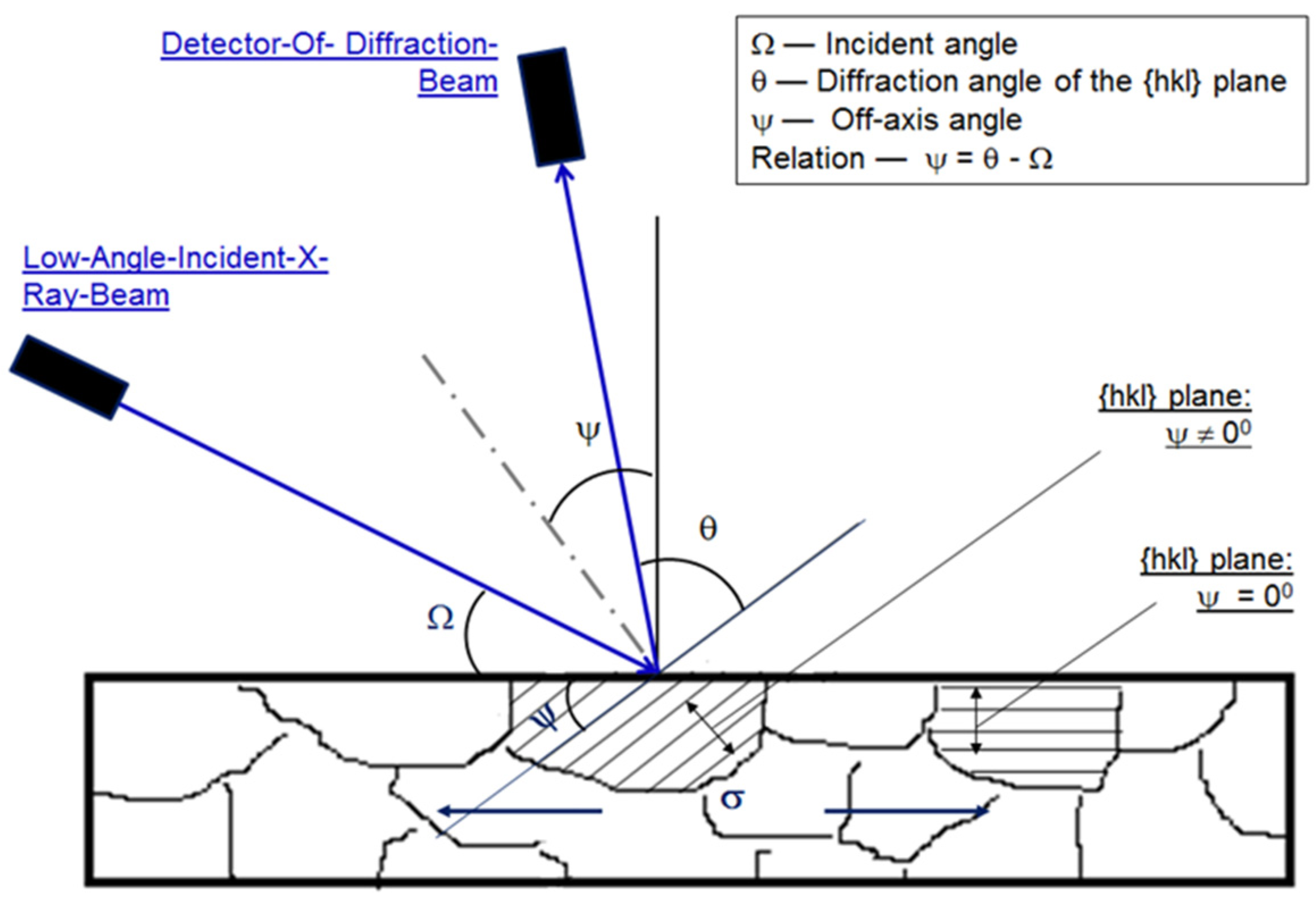
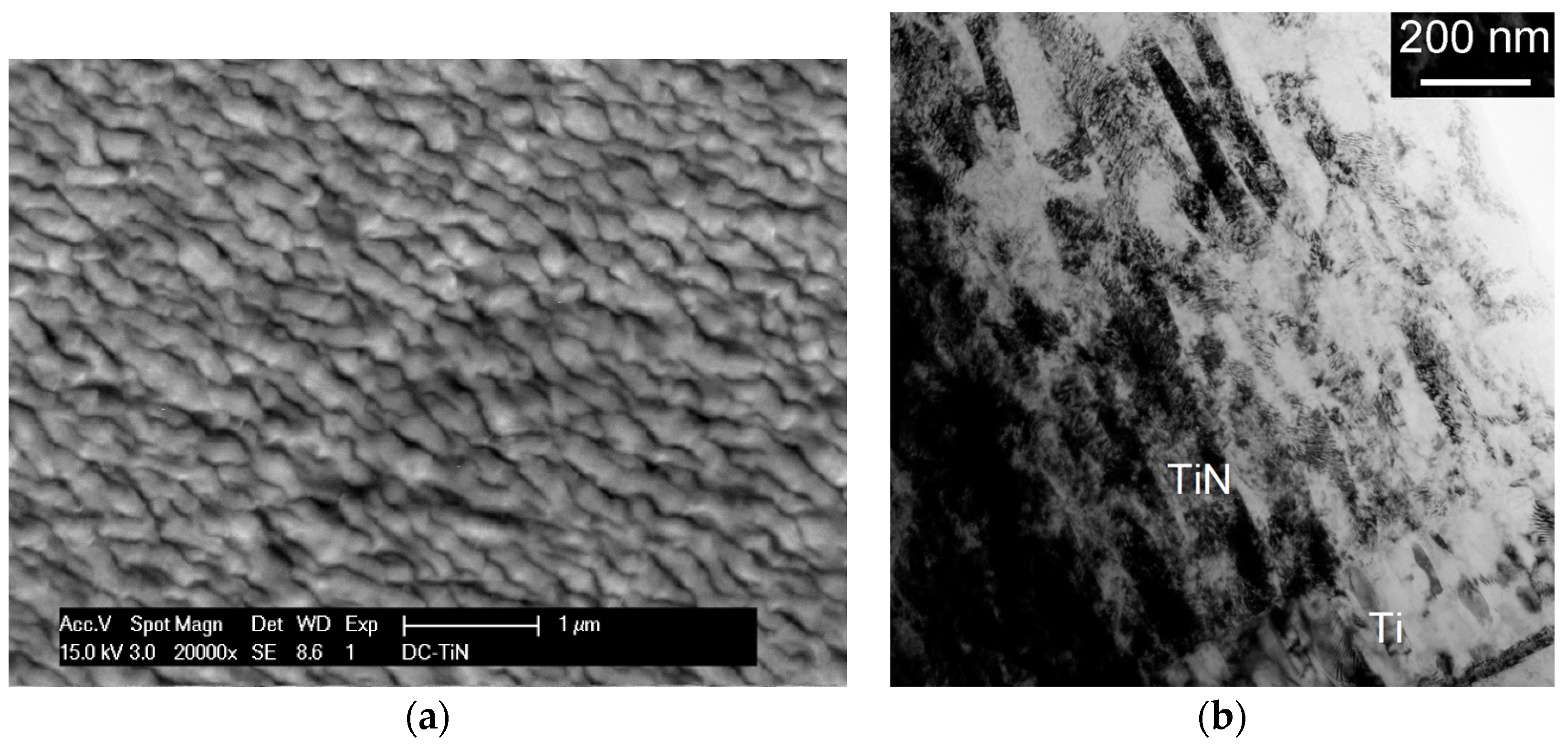
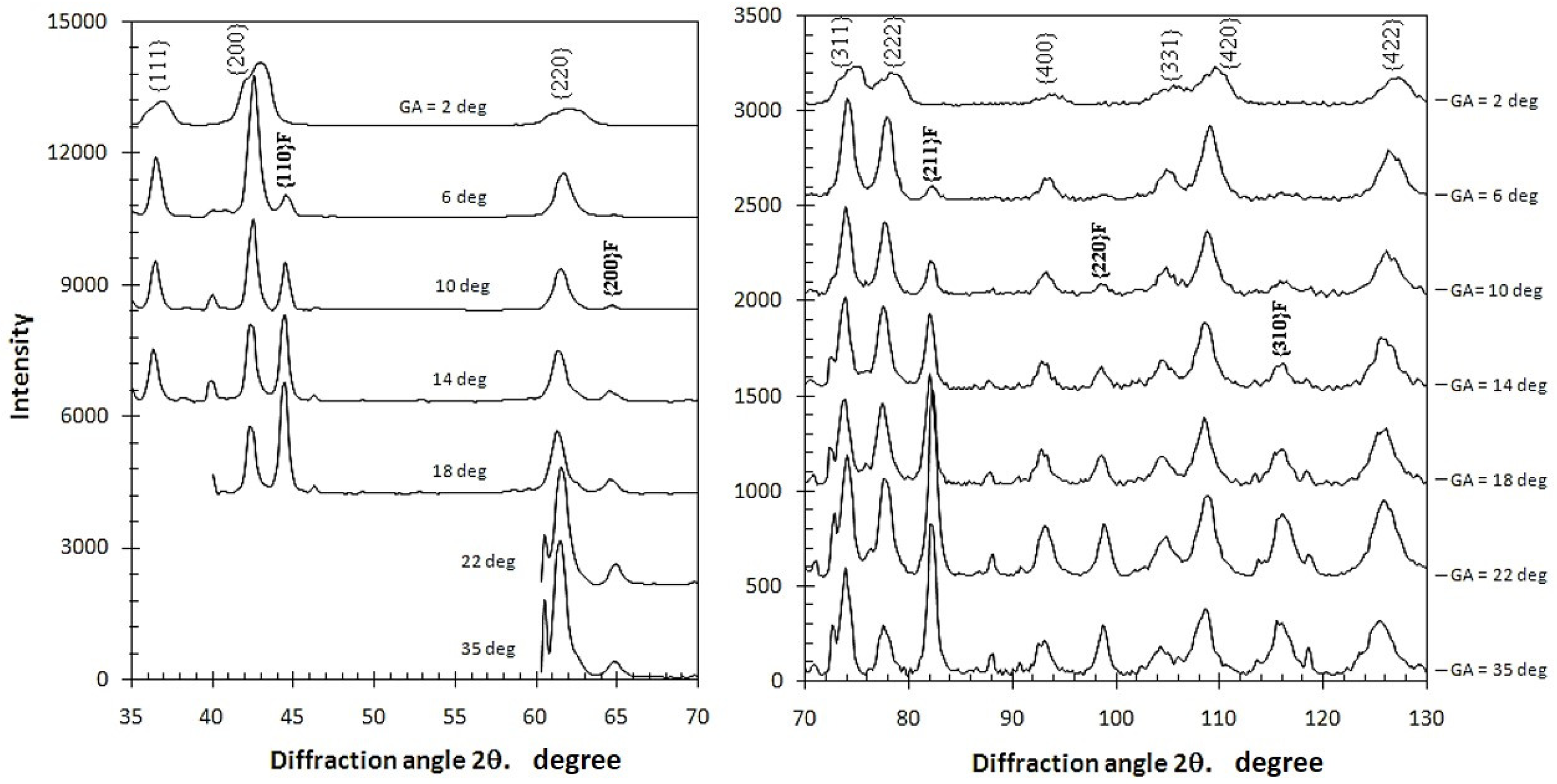

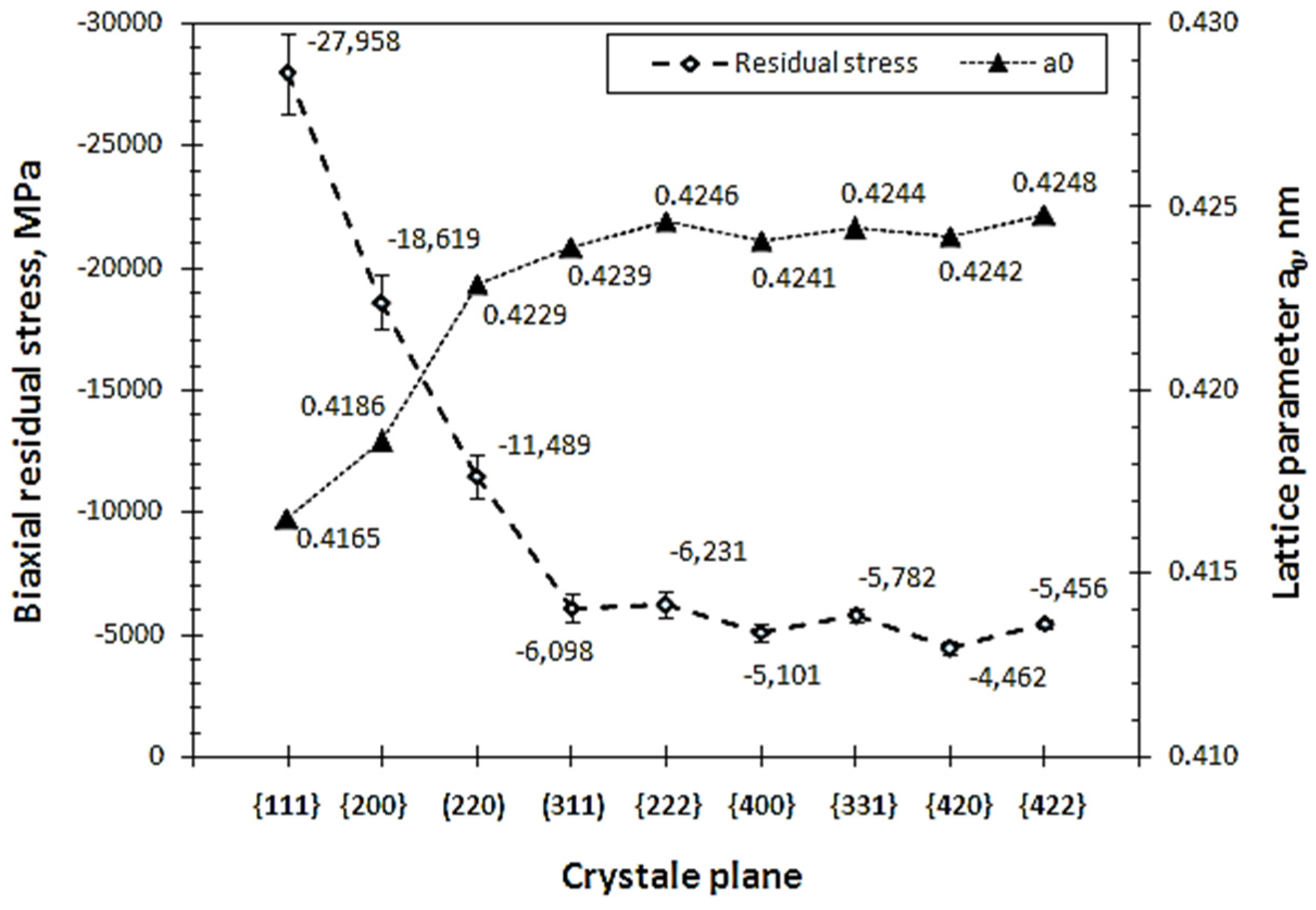


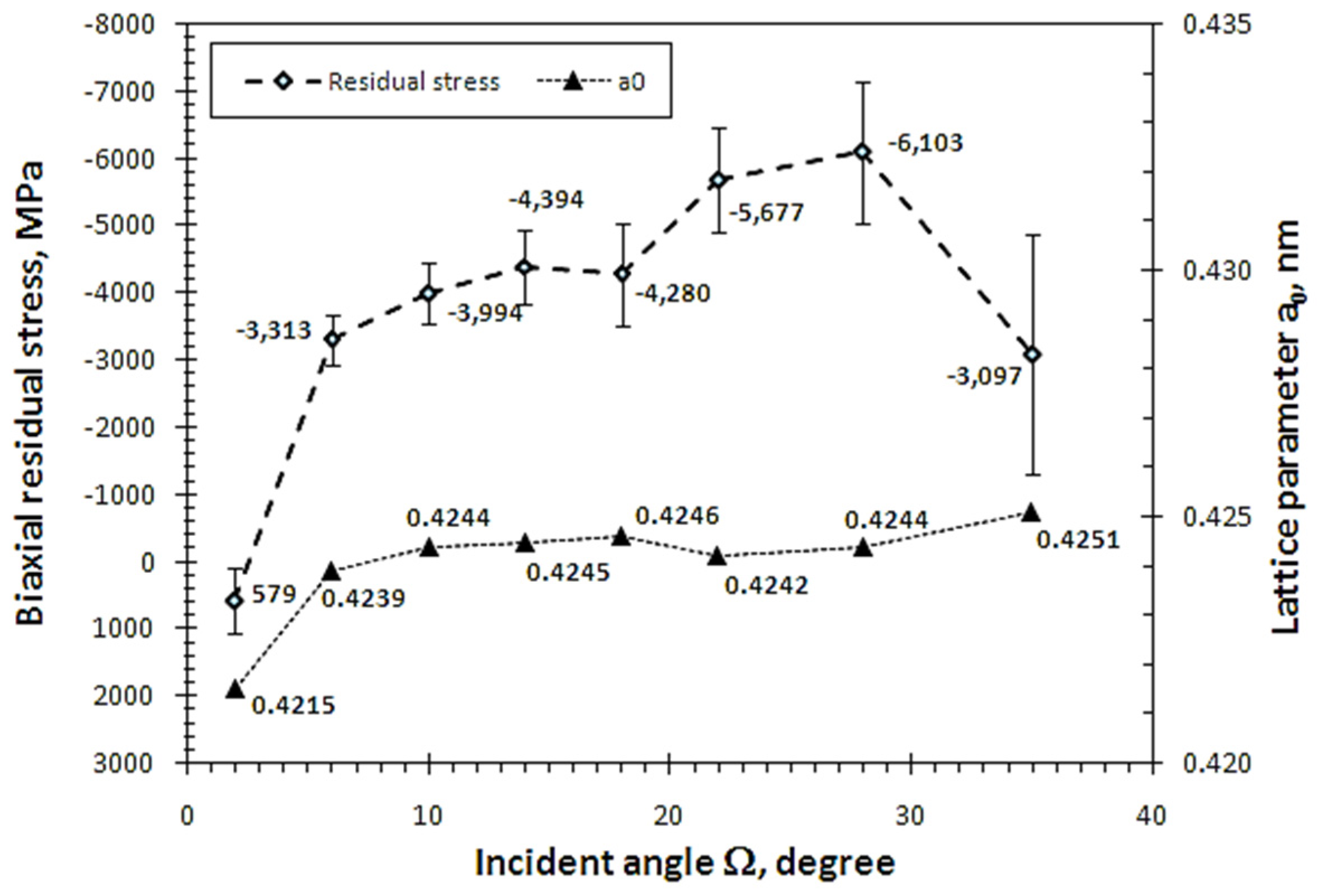
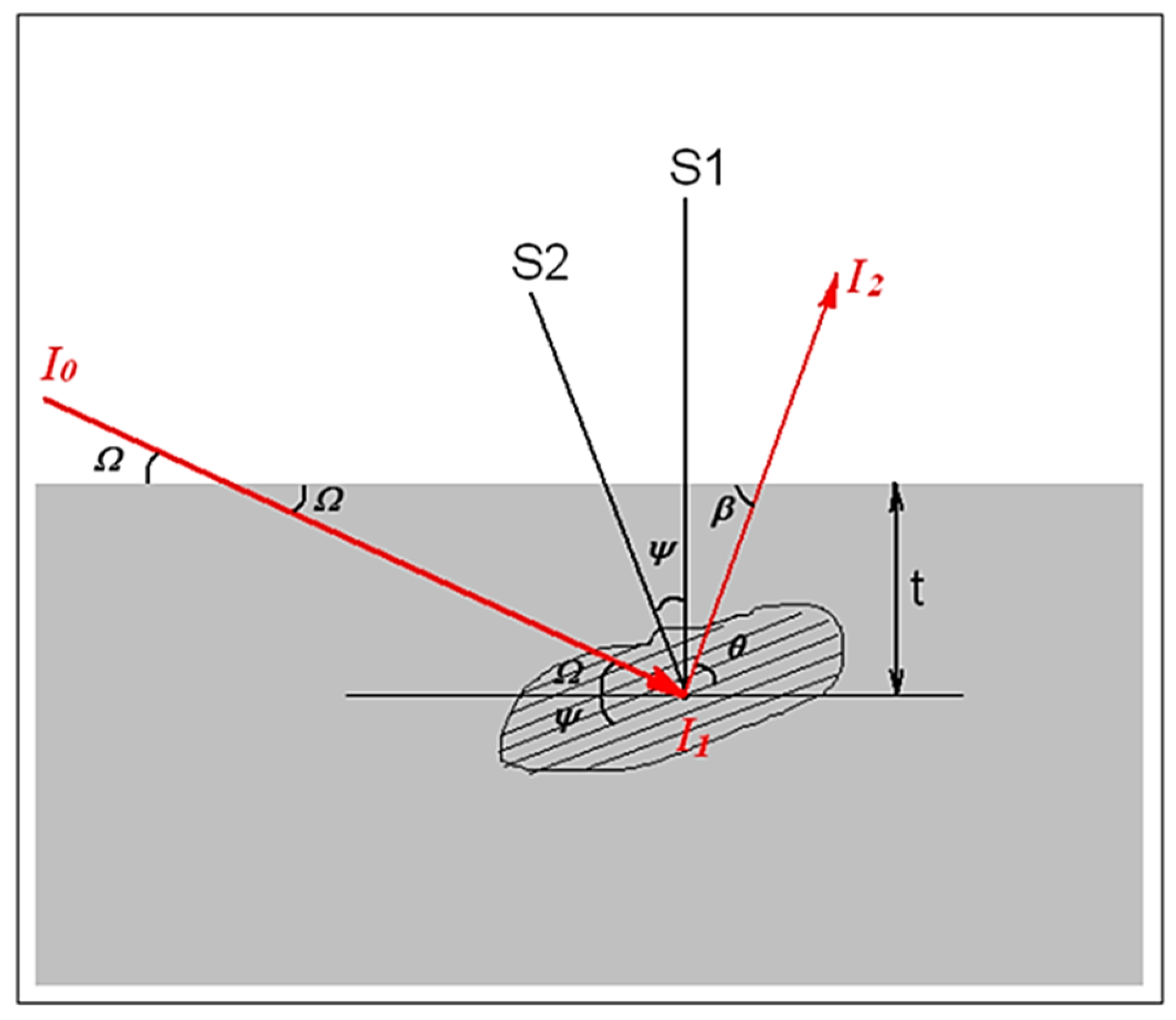

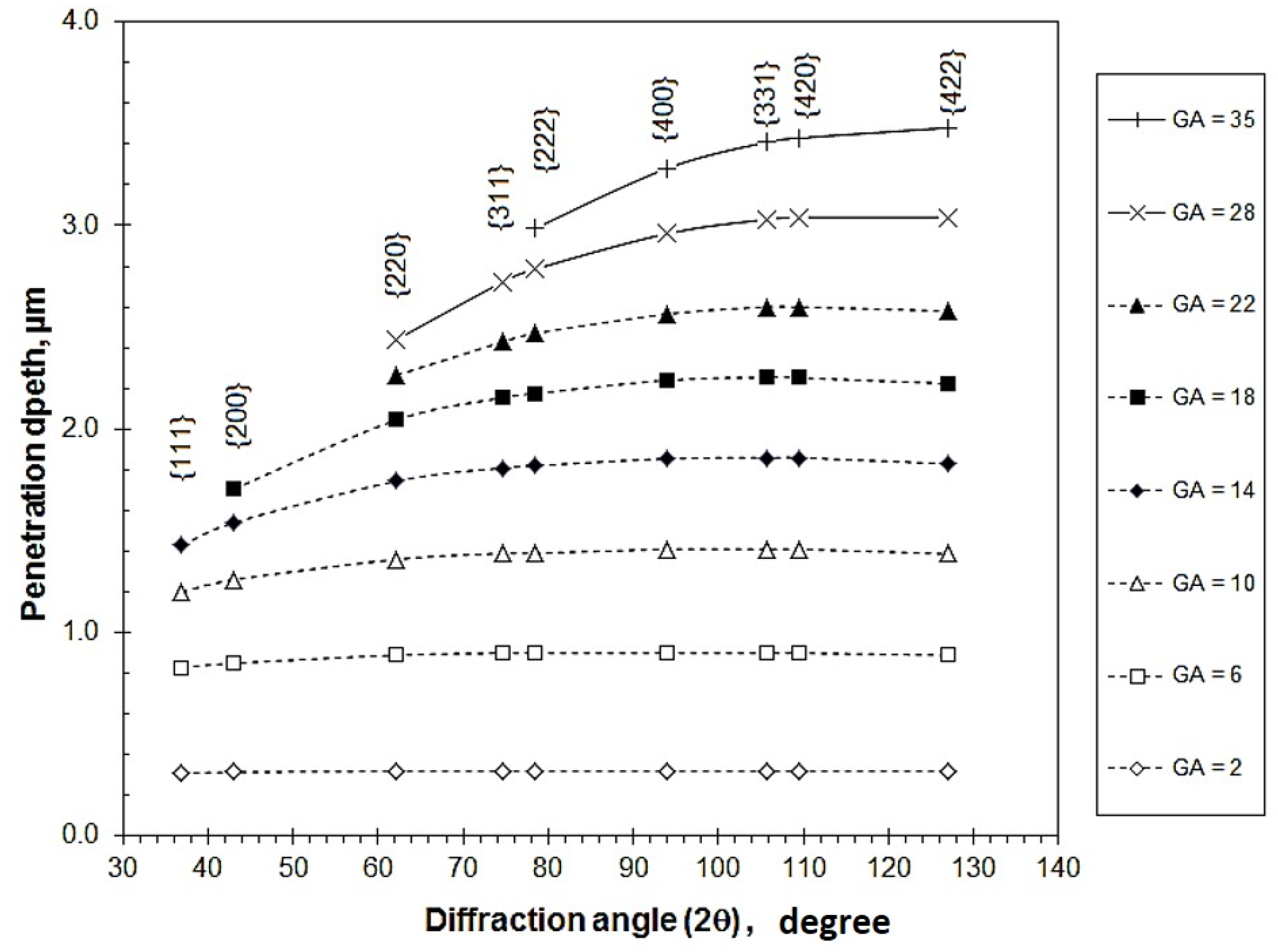
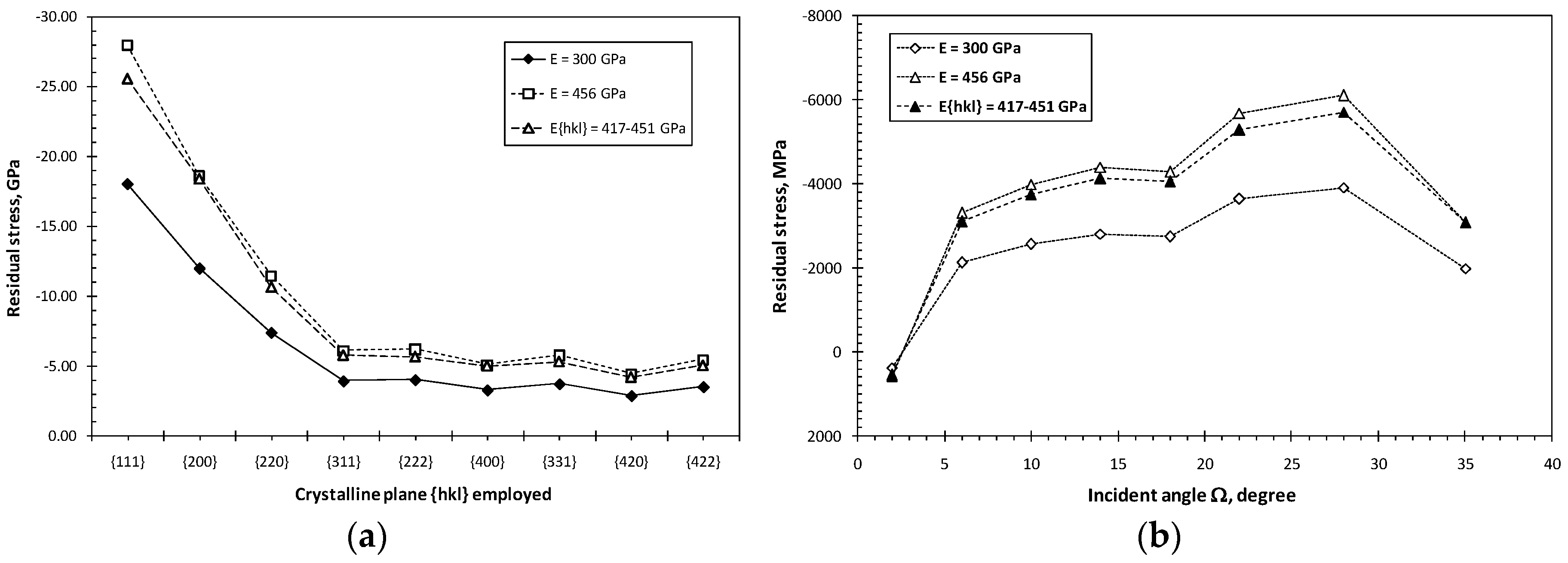
| Lattice Plane | E [GPa] |
|---|---|
| {111}, {222} | 417 |
| {200}, {400} | 451 |
| {111}, {222} | 424 |
| {200}, {400} | 434 |
| Ω | {111} | {200} | Ω | {220} | {311} | {222} | {400} | {331} | {420} | {422} |
|---|---|---|---|---|---|---|---|---|---|---|
| 2 | 36.93 | 42.96 | 2 | 62.16 | 74.74 | 78.35 | 93.85 | 105.75 | 109.55 | 127.00 |
| 4 | 36.62 | 42.67 | 6 | 61.71 | 74.07 | 77.87 | 93.39 | 105.01 | 109.07 | 126.54 |
| 6 | 36.56 | 42.61 | 10 | 61.55 | 73.92 | 77.69 | 93.20 | 104.80 | 108.82 | 126.23 |
| 8 | 36.51 | 42.55 | 14 | 61.49 | 73.85 | 77.57 | 93.08 | 104.71 | 108.69 | 126.04 |
| 10 | 36.49 | 42.53 | 18 | 61.41 | 73.80 | 77.50 | 92.99 | 104.56 | 108.56 | 125.81 |
| 12 | 36.49 | 42.50 | 22 | 61.42 | 73.82 | 77.51 | 92.98 | 104.51 | 108.60 | 125.75 |
| 14 | 36.46 | 42.50 | 28 | 61.31 | 73.69 | 77.40 | 92.75 | 104.21 | 108.37 | 125.26 |
| 16 | 36.46 | 42.49 | 35 | – | – | 77.42 | 92.77 | 103.96 | 108.11 | 124.88 |
| 18 | – | 42.48 | – | – | – | – | – | – | – | – |
| Parameters | {111} | {200} | {220} | {311} | {222} | {400} | {331} | {420} | {422} |
|---|---|---|---|---|---|---|---|---|---|
| Slope (10−2) | −3.06 | −2.05 | −1.28 | −0.68 | −0.70 | −0.57 | −0.65 | −0.50 | −0.61 |
| R2 | 0.96 | 0.95 | 0.96 | 0.91 | 0.92 | 0.95 | 0.97 | 0.95 | 0.99 |
| σ (MPa) | −17,999 | −11,974 | −7383 | −3917 | −4002 | −3276 | −3713 | −2865 | −3504 |
| Δσ (MPa) | 1667 | 1083 | 809 | 611 | 535 | 340 | 276 | 292 | 184 |
| a0 (nm) | 0.4152 | 0.4178 | 0.4224 | 0.4236 | 0.4243 | 0.4239 | 0.4241 | 0.424 | 0.4246 |
| Incident Angle | 2 | 6 | 10 | 14 | 18 | 22 | 28 | 35 |
|---|---|---|---|---|---|---|---|---|
| Slope (10−3) | 0.64 | −3.70 | −4.46 | −4.91 | −4.78 | −6.34 | −6.82 | −3.46 |
| R2 | 0.08 | 0.82 | 0.81 | 0.8 | 0.69 | 0.82 | 0.74 | 0.29 |
| σ (MPa) | 579 | −3313 | −3994 | −4394 | −4280 | −5677 | −6103 | −3097 |
| Δσ (MPa) | 759 | 588 | 723 | 845 | 1172 | 1215 | 1633 | 2783 |
| a0 (nm) | 0.4215 | 0.4239 | 0.4244 | 0.4245 | 0.4246 | 0.4242 | 0.4244 | 0.4251 |
© 2017 by the authors. Licensee MDPI, Basel, Switzerland. This article is an open access article distributed under the terms and conditions of the Creative Commons Attribution (CC BY) license (http://creativecommons.org/licenses/by/4.0/).
Share and Cite
Luo, Q.; Yang, S. Uncertainty of the X-ray Diffraction (XRD) sin2 ψ Technique in Measuring Residual Stresses of Physical Vapor Deposition (PVD) Hard Coatings. Coatings 2017, 7, 128. https://doi.org/10.3390/coatings7080128
Luo Q, Yang S. Uncertainty of the X-ray Diffraction (XRD) sin2 ψ Technique in Measuring Residual Stresses of Physical Vapor Deposition (PVD) Hard Coatings. Coatings. 2017; 7(8):128. https://doi.org/10.3390/coatings7080128
Chicago/Turabian StyleLuo, Quanshun, and Shicai Yang. 2017. "Uncertainty of the X-ray Diffraction (XRD) sin2 ψ Technique in Measuring Residual Stresses of Physical Vapor Deposition (PVD) Hard Coatings" Coatings 7, no. 8: 128. https://doi.org/10.3390/coatings7080128




